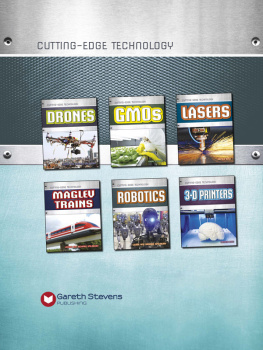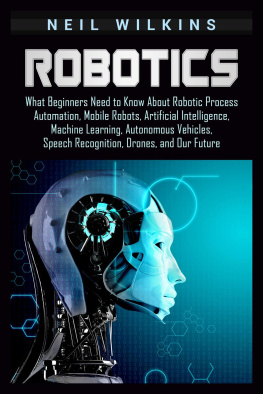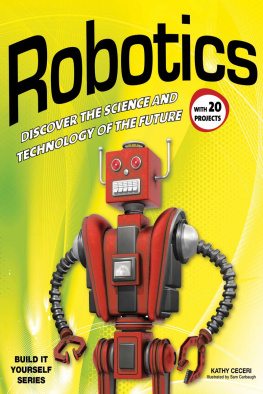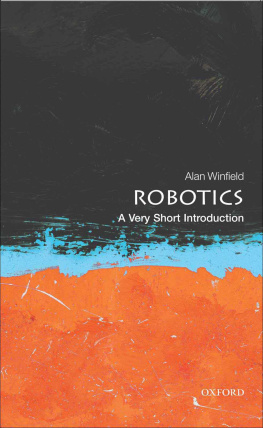Acknowledgments
This volume is primarily the result of precious dedication on the part of the authors of the chapters. They are the pioneers in the field of cognitive robotics. Notwithstanding their busy jobs juggling teaching, research, paper and grant writing, and institutional administration roles, they kindly volunteered their time and effort in writing these chapters. Each author also acted as an anonymous cross-referee of other chapters, to assure the quality and clarity of the work.
We would also like to thank the staff at MIT Pressin particular Marie L. Lee for her enthusiasm and support for the book proposal and Elizabeth P. Swayze and Alex Hoopes for their support in the later stages of manuscript preparation. Special thanks go to Stella Cangelosi for the thorough help in the bibliography and manuscript formatting.
The initial idea of and work on this project began during one of Angelo Cangelosis visits to the Artificial Intelligence Research Centre of the Japanese National Institute of Advanced Industrial Science and Technology (AIST). These visits were supported by an AIST grant to the University of Manchester. A particular thank you goes to the AIST director Junichi Tsujii, colleagues Tetsuya Ogata, Kristiina Jokinen, and Junpei (Joni) Zhong at AIST, and Sophia Ananiadou at Manchester for making this collaboration possible.
Angelo Cangelosis work on cognitive robotics, as well as this volume, was also possible thanks to the generous support of research grants from the European Union Horizon 2020 program (i.e., the projects STRoNA, DCOMM, eLADDA, TRAINCREASE and PERSEO), the US Air Force Office of Scientific Research (project THRIVE ++ , AFOSR-EOARD Award FA9550-19-1-7002), the Honda Research Institute Europe (DeCIFER project), and the UK Research and Innovation Trustworthy Autonomous Systems Node in Trust.
Minoru Asada and his research group have been working in this area for more than a quarter century, and the following research projects contributed to their work, some of which are introduced in this book: Japan Science and Technology Agency Exploratory Research for Advanced Technology Asada Synergistic Intelligence Project (20052011); Japan Society for the Promotion of Science Grant-in-Aid for Specially Promoted Research on Constructive Developmental Science Based on Understanding the Process from Neuro-Dynamics to Social Interaction (20122016 PI: Minoru Asada); and Scientific Research on Innovative Areas, a Ministry of Education, Culture, Sports, Science and Technology Grant-in-Aid Project on Constructive Developmental Science (20122016 PI: Yasuo Kuniyoshi).
Cognitive Architectures
David Vernon
10.1Introduction
As the definition of cognitive robotics in chapter 1 makes clear, the field draws on several disciplines, including robotics, artificial intelligence, and cognitive science. Its goal is to design an integrated cognitive system that combines a range of abilities, such as sensorimotor behaviors, knowledge-based reasoning, and social skills, in the form of an intelligent robot. Its foundations in systems engineering and cognitive science coalesce in a single concept: a cognitive architecture.
From the perspective of systems engineering, a cognitive architecture mirrors the system architecture, using the power of abstraction to render the modeling, specification, and design of a complete complex system tractable.
From the perspective of cognitive science, in which the term cognitive architecture originates (Newell 1990), the concept of a cognitive architecture is the result of over sixty years of research. To understand what it means from this perspective requires us to first familiarize ourselves with the roots of cognitive science and the different paradigms that exist within that discipline. In turn, this will allow us to understand the different types of cognitive architecture and the role a cognitive architecture plays in cognitive science, in general, and cognitive robotics, in particular.
With this understanding in place, we review the key attributes of a cognitive architecture before surveying the core cognitive abilities of the many cognitive architectures that exist today. We examine two cognitive architectures in some detail to highlight the way these abilities are realized in cognitive robots. We finish by exploring what the future might hold for cognitive architectures and the challenges that remain.
10.2The Foundations of Cognitive Science
Cognitive science embraces neuroscience, cognitive psychology, linguistics, epistemology, philosophy, and artificial intelligence, among other disciplines. Its primary goal is to explain the underlying processes of human cognition, ideally in the form of a model that can be replicated in artificial agents. It has its roots in cybernetics in the early 1940s (Wiener 1948) but appears as a formal discipline referred to as cognitivism in the late 1950s. Cognitivism built on the logical foundations laid by the early cyberneticians and exploited the computer as a literal metaphor for cognitive function and operation, using symbolic information processing as its core model of cognition. Cybernetics also gave rise to the alternative emergent systems approach, which recognized the importance of self-organization in cognitive processes, eventually embracing connectionism, dynamical systems theory, and the enactive perspective on cognitive science. Hybrid systems attempt to combine the cognitivist and emergent paradigms to varying degrees, quite often ignoring some of the incompatible assumptions that the cognitivist and the emergent paradigms make about the fundamental nature of cognition (Vernon 2014).
10.2.1The Cognitivist Paradigm of Cognitive Science
The cognitivist paradigm, which embraces artificial intelligence (AI), dates from a conference held at Dartmouth College, New Hampshire, in July and August 1956. It was attended by Allen Newell, Herbert Simon, John McCarthy, Marvin Minsky, and Claude Shannon, among others, all of whom exerted a very significant influence on the development of AI over the next half century.
The essential position of cognitivism is that cognition is achieved by computations performed on internal symbolic knowledge representations in a process whereby information about the world is taken in through the senses, filtered by perceptual processes to generate descriptions that abstract away irrelevant data, represented in symbolic form, and reasoned about to infer what is required to perform some task and achieve some goal. In the cognitivist paradigm, any physical platform that supports the performance of the required symbolic computation will suffice. In other words, the physical realization of the computational model is inconsequential to the model. The principled decoupling of computational operation from the physical platform that supports these computations is referred to as computational functionalism (Piccinini 2010). Allen Newell made several landmark contributions to the establishment of practical cognitivist systems: in the early 1980s with his introduction of the concept of a knowledge-level system, the maximum rationality hypothesis, and the principle of rationality (Newell 1982); in the mid-1980s with the development of the Soar cognitive architecture for general intelligence (along with John Laird and Paul Rosenbloom; Laird, Newell, and Rosenbloom 1987); and in 1990 with the concept of a unified theory of cognition (Newell 1990)that is, a theory that covers a broad range of cognitive issues, such as attention, memory, problem-solving, decision-making, and learning from several aspects, including psychology, neuroscience, and computer science.
10.2.2The Emergent Paradigm of Cognitive Science
In the emergent paradigm, cognition is one of the processes by which an autonomous system maintains its autonomy. Through cognition, the system constructs its realityits world and the meaning of its perceptions and actionsas a result of its operation in that world. This process of making sense of its environmental interactions is one of the foundations of a branch of cognitive science called









